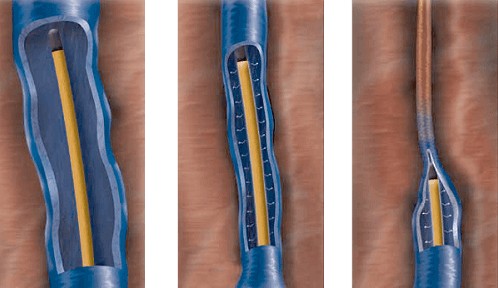Radiofrequency ablation (RFA)
Radiofrequency ablation (RFA) is also known as Venefit or VNUS Closure. The FDA approved it in 1999. RFA is more efficacious than vein stripping and has fewer complications. Radiofrequency ablation truly has revolutionized how varicose veins are treated, and is one of the new standards for treating venous insufficiency and varicose veins. It represents a minimally invasive way to remove varicose veins using radiofrequency energy delivered through a catheter. The catheter closes the vein from the inside. This treatment requires only a tiny incision in the leg. It is often done in the office using only local anesthesia and does not require a hospital stay. Most patients find that the procedure nearly painless and the vast majority of patients are back to their usual routine by the next day.
Radiofrequency ablation (RFA) is truly remarkable because it provides a less invasive means of treating venous insufficiency without vein removal surgery. In the not so distant past, surgeons removed poorly functioning veins using a procedure called vein stripping. This involved making two incisions in the leg and literally “ripping out” the veins. This treatment was effective but it caused pain and sometimes required weeks to fully recover.
Candidates and preparation
 Patients seeking radiofrequency ablation need an ultrasound to determine if they have venous insufficiency which is the primary cause of varicose veins. It is also necessary to assess the size of the vein and other factors to determine if this is the proper surgery. This allows the vascular surgeon to determine which vein or veins to treat. Because this is a minimally invasive invasive procedure, there is little preparation. General anesthesia is not necessary although patients may sometimes take something to relax. See our patient forms for instructions on preparing for and recovering after radiofrequency ablation.
Patients seeking radiofrequency ablation need an ultrasound to determine if they have venous insufficiency which is the primary cause of varicose veins. It is also necessary to assess the size of the vein and other factors to determine if this is the proper surgery. This allows the vascular surgeon to determine which vein or veins to treat. Because this is a minimally invasive invasive procedure, there is little preparation. General anesthesia is not necessary although patients may sometimes take something to relax. See our patient forms for instructions on preparing for and recovering after radiofrequency ablation.
Radiofrequency ablation works in a very similar fashion to endovenous laser therapy. (See comparisons) After identifying and mapping the diseased vein or veins to treat, the surgeon creates a small incision and guides a catheter to the groin area. The typical veins treated are the superficial veins which are the greater saphenous vein and the lesser saphenous vein. Radiofrequency pulses allow the catheter to apply heat to the collagen in the walls of the vein which causes the vein to shrink and close. The catheter treats 7 cm sections of the vein at a time for 20 seconds. After each section is treated, the surgeon partially withdraws the catheter to treat the next section until the entire vein is closed. By closing the disease vein, the healthier functioning veins take over.
Procedure
A tumescent fluid is an important part of radiofrequency ablation. The solution is a mixture of saline solution, lidocaine, and sodium bicarbonate solution. Using ultrasound, the surgeon injects it between the vein and surrounding tissue. It serves many purposes:
- The tumescent fluid acts as a buffer between the vein and surrounding tissue and protects the tissue from damage from the radiofrequency waves. It allows the surgeon to treat only the vein.
- The fluid applies pressure to the outside of the vein so that the catheter contacts the vein walls and effectively closes the vein.
- The lidocaine in the fluid minimizes pain.
Recovery
There are very few limitations after RFA. We encourage patients to refrain from strenuous exercise for several days. We suggest walking frequently as it helps the recovery process. Compression stockings are also important for recovery. We advise patients to wear them continuously for the first day. Patients should wear the stockings for the full first day and during the day only for about two weeks or until the follow up visit. During the follow up visit. the surgeon will use check the ablated vein to make sure it is properly closed.
Relief of varicose vein symptoms like pain, heaviness, etc typically disappear within weeks, Occasionally, it takes longer. However in about 10 % of patients, the veins don’t disappear completely. If that happens, we can either do injections a few months down the road, or in some cases, we surgically remove the veins. Some patients report sensitivity around the treated area which typically subsides after a few weeks.
Success rate
The closure success rate for RFA is 99%. Over time, a successfully closed vein can sometimes open up again. The recurrence rate ranges from 5% to 10%. Patients who experience recurrence can decide whether or not to perform the procedure again.
Risks and side effects
Radiofrequency is a low risk procedure. Some bruising and swelling along with some discomfort is common. Wearing compression stockings will help with this. Because of the bruising and need to wear compression stockings, we recommend this procedure during the cooler months of the year.
Deep vein thrombosis (DVT) is when a blood clot forms the vein. There is roughly a 1% risk for this complication. About half of patients who form a DVT can develop a pulmonary embolism where the blood clot travels to the lungs. This is a rare but dangerous condition that needs to be treated immediately with blood thinners when it happens. Following the recovery guidelines of walking, wearing compression stockings, and not sitting for prolonged periods helps to decrease these risks.
